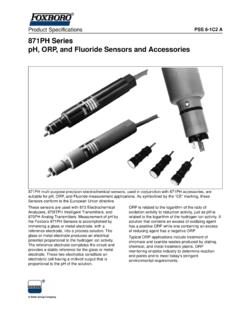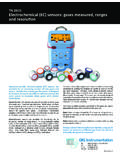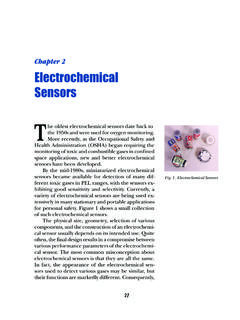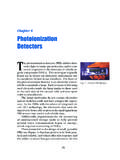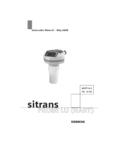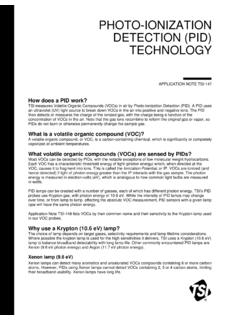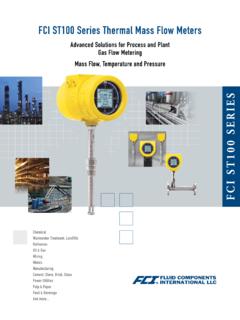Transcription of Application Data: The Theory of pH Measurement
1 PH Measurement has a wide variety of industrialapplications in virtually every industry. These rangefrom water conditioning to specific process relatedmeasurements to waste IS pH? pH is a measure of the acidity or alkalinity of a watersolution. The acidity or alkalinity of a water solution isdetermined by the relative number of hydrogen ions(H+) or hydroxyl ions (OH-) present. Acidic solutionshave a higher relative number of hydrogen ions, whilealkaline (also called basic) solutions have a higherrelative number of hydroxyl ions. Acids are substanceswhich either dissociate (split apart) to release hydrogenions or react with water to form hydrogen ions. Basesare substances that dissociate to release hydroxylions or react with water to form hydroxyl water solutions, the product of the molar concentra-tions1of hydrogen and hydroxyl ions is equal to adissociation constant (Kw).
2 Knowing the value of theconstant and the concentration of hydrogen ionsmakes it possible to calculate the concentration ofhydroxyl ions, and vice versa. At 25 C, the value of Kwis 10-14 (see Figure 1).The concentration of hydrogen and hydroxyl ions canvary over 15 orders of magnitude in water common household items can reflect this widevariation (Figure 2).pH is strictly defined as the negative logarithm of thehydrogen ion activity (aH):pH = -log10aHThe hydrogen ion activity is defined as the molarconcentration of hydrogen ions multiplied by an activitycoefficient, which takes into account the interaction ofhydrogen ions with other chemical species in the practice, pH is often assumed to be the negativelogarithm of the hydrogen ion concentration:pH = - log10[H+]In this form, the usefulness of pH as a convenientshorthand for expressing hydrogen ion concentrationcan be seen on page 2, Figure 3.
3 At 25 C, a neutral solution has a pH of , while solu-tions with pH < 7 are acidic and solutions with pH > 71 Molar concentration is a Measurement of the number of atoms, moleculesor ions in a 1. Acids and BasesFIGURE 2. pH Values of Acids and BasesAcids:HA H++ A-acid hydrogen ion anionBases:MOH OH-+ M+base hydrogen ion cation(H+) x (OH-) = Kw= 10-14(25 C)The Theory of pH MeasurementTheoryApplication Data SheetADS 43-002 2010are alkaline. The normal overall pH range is 0 to 14pH, although solutions containing non-water solventscan have pH values outside this range. THE Measurement OF pHpH Measurement is based on the use of a pH sensi-tive electrode (usually glass), a reference electrode,and a temperature element to provide a temperaturesignal to the pH pH electrode uses a specially formulated, pHsensitiveglass in contact with the solution, which develops apotential (voltage) proportional to the pH of reference electrode is designed tomaintain a constant potential at any given temperature,and serves to complete the pH measuring circuit withinthe solution.
4 It provides a known reference potentialfor the pH electrode. The difference in the potentials ofthe pH and reference electrodes provides a millivoltsignal proportional to pH sensors are designed to produce a 0 mVsignal at pH, with a (theoretically ideal) slope(sensitivity) of mV / pH at 25 Need for Temperature MeasurementThe millivolt signals produced by the pH and referenceelectrodes are temperature dependent. However, thepH and reference electrode combination exhibits anisopotential point, which is a pH and millivolt potentialat which the potential is constant with temperaturechanges. The isopotential point is most frequentlydesigned to be at pH and 0 mV.
5 Using the isopo-tential point with a theoretical knowledge of electrodebehavior makes it possible to compensate (correct)the pH Measurement at any temperature to a referencetemperature (usually 25 C), using a temperature signalfrom the temperature element. This makes the pHmeasurement independent of changes in the elec-trodes' output with Measurement IN PROCESS SOLUTIONSThe potential effects of process solutions on pH sensorswill require a more detailed look at the construction ofpH and reference electrodes. But first, some basicproperties of the pH of water solutions need to IN AQUEOUS SOLUTIONSP ractical pH Measurement RangeAlthough the range of pH measurements is defined tobe 0 to 14 pH, solutions with pH values near theextremes of this range are often better measuredusing conductivity.
6 At pH values below pH, the glass pH electrodecan be subject to acid errors, and the sensor can be2 Rosemount AnalyticalFIGURE 3. Ion Concentration, MOL/Lsubject to chemical attack. Solutions with a pH in thisrange have an acid concentration at, or approaching thepercent by weight range, which will have conductivitylikely to be large in comparison to other electrolytes inthe solution. A toroidal conductivity Measurement , witha read-out in percent acid, can often be successfullyapplied in these cases and will be a far more accuratemeasurement of acid concentration than the case of high pH, the reason for switching to aconductivity Measurement is more compelling: highlyalkaline solutions quickly destroy glass pH the nominal pH is expected to be above 13 pH, aconductivity Measurement should be pH Changes with TemperatureThe pH of a solution can change with temperature,due to the effect of temperature on the dissociation ofweak acids and bases, and the dissociation of wateritself.
7 In fact, any solution with a pH of 7 or above willhave some degree of temperature dependence. Howmuch this will affect the Measurement will dependupon the composition of the solution and how high thenominal process temperature is above 25 C. Thisbehavior is frequently the explanation for discrepanciesbetween laboratory and on-line pH pH analyzers allow their temperature compen-sation routines to be modified to take into accountsolution pH changes with temperature as well aschanges in the millivolt output of the entering the temperature coefficient of thesolution (pH change per degree C) into the analyzerdoes this. While the temperature coefficient can becalculated for simple cases, it is often necessary tomeasure it in the laboratory by noting the pH at varioustemperatures.
8 If the composition of a processchanges, the temperature coefficient can also change;therefore, the final product composition should beused for determining the solution with Mixed SolventsThe conventional pH analyzer and sensor aredesigned to measure the pH in water solutions. Whena non-water solvent is present in appreciable quantities,the pH reading will be shifted from the expected valueby effects of the non-water solvent on the pH andreference electrodes, and effects on the activity ofhydrogen ion itself. Since pH sensor components aredesigned for use in water, the non-water solvent mayattack seals and are a few mixed solvent cases that can beconsidered: (1) A solvent that is miscible with (mixes with) watermay cause a shift in the pH reading, but if the solvent'sconcentration is above 15% by weight, it may dry thepH electrode, requiring periodic rewetting of the sensorby water.
9 (2) A solvent that is non-miscible with water will likelynot have an appreciable concentration of hydrogenions; most will be in the water phase. It is better tomake the Measurement in a place in the processwhere the water and solvent phases separate andkeep the pH sensor in the water phase. (3) Completely non-water process measurements mayonly be possible with periodic rewetting of the pHsensor with water, and may also require a speciallydesigned reference electrode. In all of the above cases, pH Measurement of themixed solvent solution should be studied in the labora-tory before going on-line, and the study should includeprolonged exposure of the pH sensor to the EFFECTS ON THE GLASS pHELECTRODEA glass pH electrode consists of an inert glass tubewith a pH sensitive glass tip, either hemispherical(bulb) or flat in shape, blown onto it.
10 The tip contains afill solution with a known pH, and it is the influence ofthis solution on the inside of the glass tip versus theinfluence of the process solution on the outside thatgives rise to its millivolt potential. Ideally, the pH elec-trode will have a slope (response) of mV/pH,but in practice, a new electrode may only have a slopeRosemount Analytical 3of -57 to -58 mV/pH. As the electrode ages, its EffectsIn addition to changing millivolt output of the pH electrode,elevated temperatures accelerate the aging of theelectrode. Extremely high or low temperatures canalternatively boil the fill solution or freeze it, causingthe electrode tip to break or crack.










